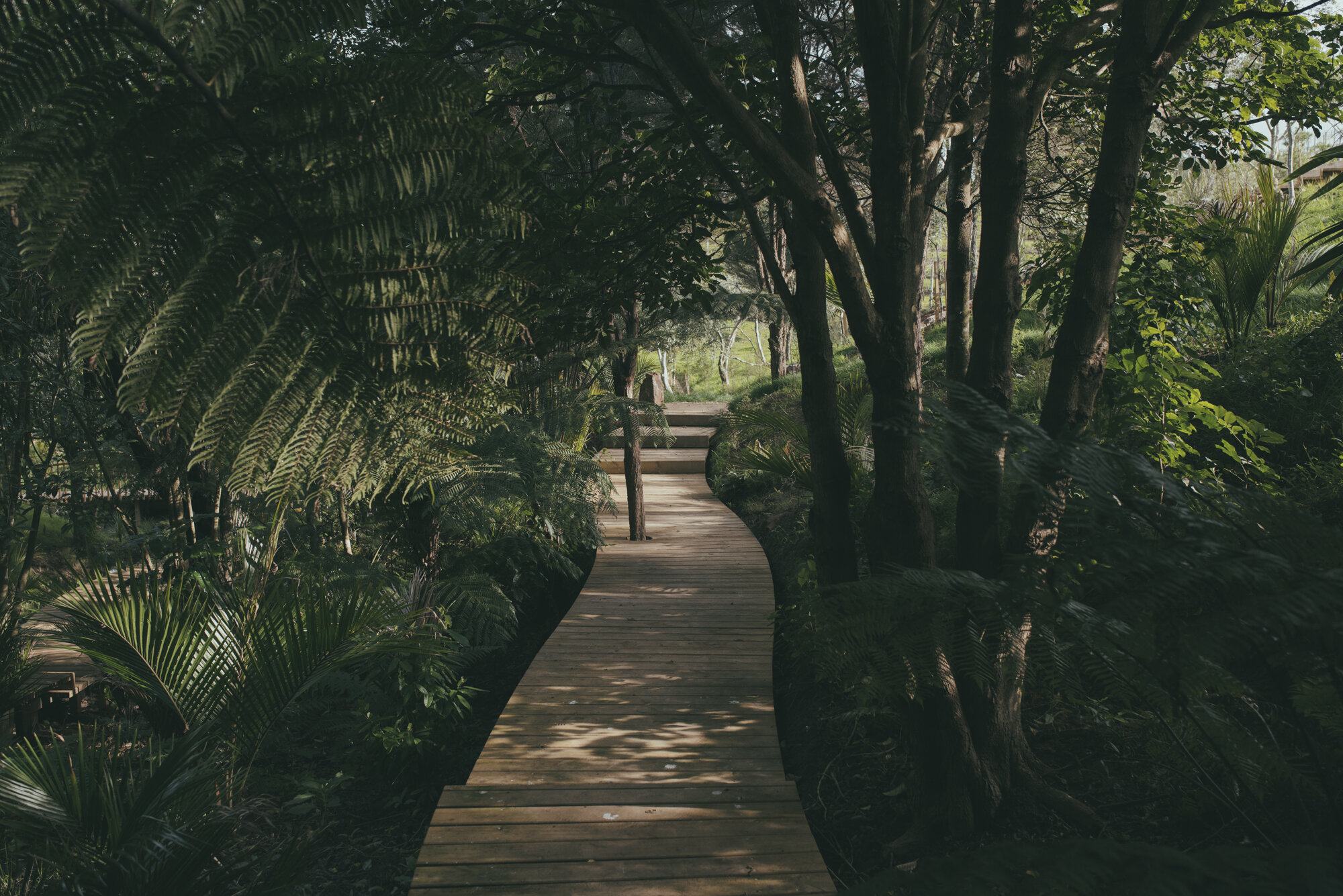Benefits of investing in a wetland
by Landscape & Ecology
Tantalus Estate is an established vineyard nestled in the idyllic Onetangi Valley, a world-class winemaking region situated on Waiheke Island, 18km east of Tamaki Makaurau, Auckland.
The 8.3-hectare property is anchored by a significant wetland depression which feeds to the farthest-reaching channels of Okahuiti Creek, drawing fresh-water from the Onetangi Valley southward, out into the Hauraki Gulf.
A boardwalk allows visitors to meander through the wetlands. Photo credit: Kate Van Der Drift
The wetland, a remnant slice of the valley's historical ecology, required a regenerative approach having faced significant disruption and degradation in recent decades, which included dumping of refuse and significant infestation of exotic weed species such as Japanese honeysuckle, convolvulus, arum lily and pampas.
Mature trees had to be released from years of smothering weed species. In response to this, a staged masterplan was developed to not only enhance but expand the existing pocket of the wetland environ, looking to restore natural ecological flows and rhythms, with the overall design emphasising resilience and reducing weed species without excessive adverse effects to the surrounding environment.
A majestic old Manoao tree. Photo credit: Kate Van Der Drift
To date, over five-thousand native plants have been reintroduced into the wetland and upon its surrounding banks, layering established trees, shrubs, ferns, sedges and grasses.
Significant research was undertaken to ensure that the design represented the best interests of not only the client but equally the resident fauna, looking to encourage increased habitat for native invertebrates, aquatic species and birds.
Existing within the site were key native tree species, hundreds of years old, including Taraire, Kohekohe, Miro, Manoao, Kahikatea and Kauri, which formed key nodes within the wetland. This small grove was critical due to the lack of large native trees in this area and has provided an important seedbank, contributing to the regenerating undergrowth throughout the site.
A timber balustrade compliments the setting, with the boardwalk floating just above the waterline. Photo credit: Kate Van Der Drift
The masterplan also introduced an extensive raised boardwalk to allow visitors to meander through the wetland, designed to navigate walkers around existing native trees and along the incised channel of mercurial water, and with luck, will enable the opportunity for nature-enthusiasts to spot a glimpse of wildlife.
The line of the boardwalk floats just above the mean high water level allowing for public access throughout the site while not impeding on seasonal hydrological change. A small grass clearing in the centre of the wetland allows for informal social gatherings, morning yoga, bird watching and a quiet, secluded spot for vineyard workers to enjoy a peaceful lunch in the shade of mature trees.
Every angle provides a perfect backdrop for wedding photos. Photo credit: Kate Van Der Drift
Tantalus Estate is a renowned wedding venue with the wetland area contributing to the tranquil outdoor ambiance of the site. The grass clearing, boardwalks and platform situated within the thick, lush bush providing ideal viewing points and backdrops for wedding and events photography.
Further development of the wetland and its surroundings are planned over the next decade, building upon the progress already made by restorative efforts to date. This includes secondary planting through establishing Manuka and Kanuka and increasing further ecological connections and corridors linking together wider patches of native vegetation around the site.
A Miro tree. Photo credit: Kate Van Der Drift
The value of investing in wetland infrastructure is initially difficult to sell as the tangible ecological results are not always immediately visible and require ongoing investment of time and maintenance to achieve quality outcomes. However the long term ecological benefits that a wetland provides are exponential.
As the wetland develops, so do the ecologies that live within it. When native vegetation is re-established and flourishing, water quality improves, aquatic life re-emerges, invertebrate and bird life return and increase.
Once a wetland system is established, it continues to build on itself, becoming more resilient, requiring less intervention and investment while providing numerous beneficial outcomes.




